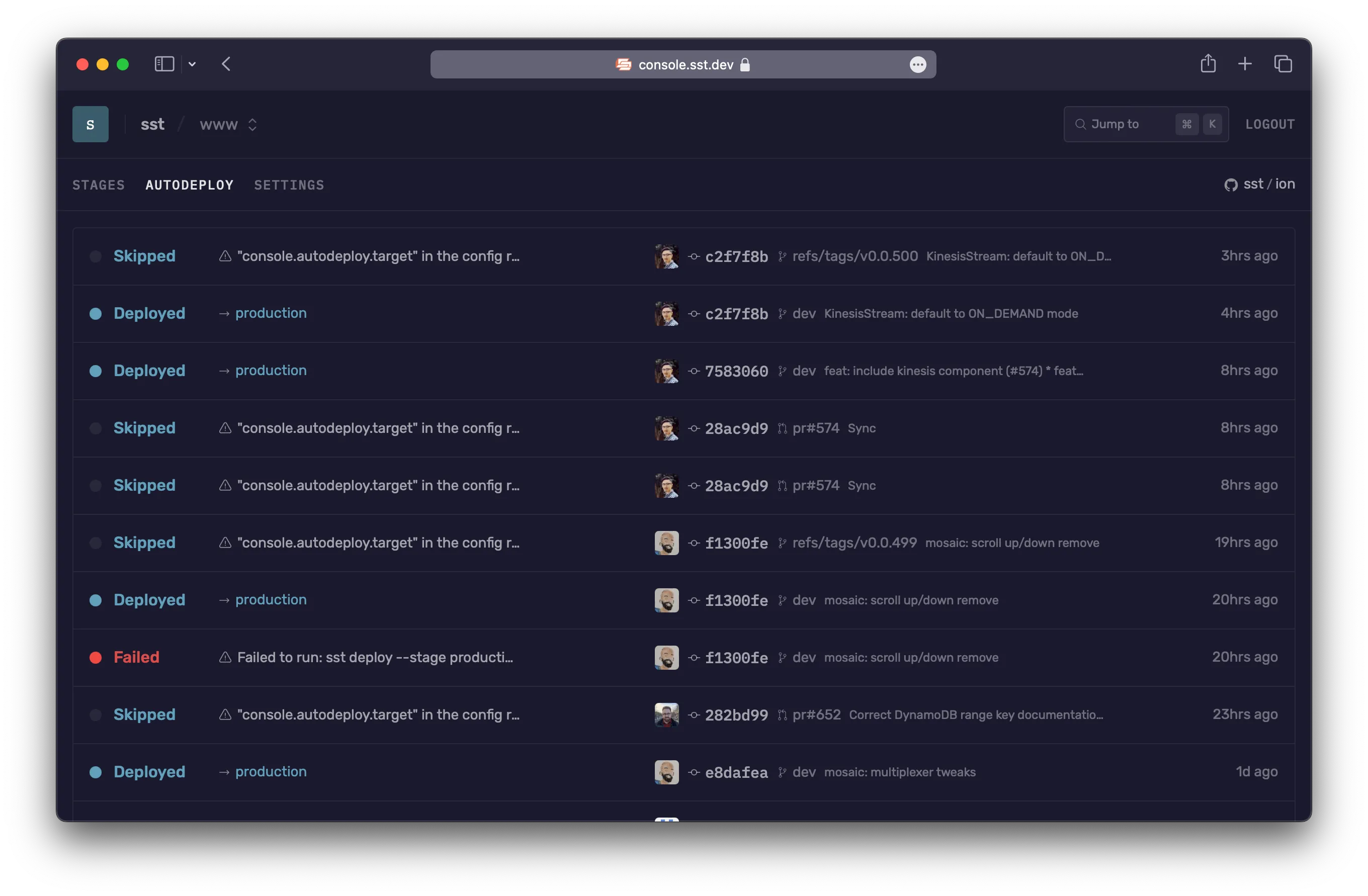Astro on AWS with SST
Create and deploy an Astro site to AWS with SST.
We are going to create an Astro site, add an S3 Bucket for file uploads, and deploy it to AWS using SST.
Before you get started, make sure to configure your AWS credentials.
1. Create a project
Let’s start by creating our project.
npm create astro@latestcd aws-astroWe are picking all the default options.
Init SST
Now let’s initialize SST in our app. Make sure to add the @ion part.
npx sst@ion initnpm installSelect the defaults and pick AWS. This’ll create a sst.config.ts file in your project root.
It’ll also ask you to update your astro.config.mjs with something like this.
import aws from "astro-sst";
export default defineConfig({ output: "server", adapter: aws()});Start dev mode
Run the following to start dev mode. This’ll start SST and your Astro site.
npx sst devOnce complete, click on MyWeb in the sidebar and open your Astro site in your browser.
2. Add an S3 Bucket
Let’s add a public S3 Bucket for file uploads. Update your sst.config.ts.
const bucket = new sst.aws.Bucket("MyBucket", { public: true});Link the bucket
Now, link the bucket to our Astro site.
new sst.aws.Astro("MyWeb", { link: [bucket],});3. Create an upload form
Add the upload form client in src/pages/index.astro. Replace the <Layout /> component with:
<Layout title="Astro x SST"> <main> <form action={url}> <input name="file" type="file" accept="image/png, image/jpeg" /> <button type="submit">Upload</button> </form> <script> const form = document.querySelector("form"); form!.addEventListener("submit", async (e) => { e.preventDefault();
const file = form!.file.files?.[0]!;
const image = await fetch(form!.action, { body: file, method: "PUT", headers: { "Content-Type": file.type, "Content-Disposition": `attachment; filename="${file.name}"`, }, });
window.location.href = image.url.split("?")[0] || "/"; }); </script> </main></Layout>Add some styles, replace the <style /> tag with:
<style> main { margin: auto; padding: 1.5rem; max-width: 60ch; } form { color: white; padding: 2rem; display: flex; align-items: center; justify-content: space-between; background-color: #23262d; background-image: none; background-size: 400%; border-radius: 0.6rem; background-position: 100%; box-shadow: 0 4px 6px -1px rgba(0, 0, 0, 0.1), 0 2px 4px -2px rgba(0, 0, 0, 0.1); } button { appearance: none; border: 0; font-weight: 500; border-radius: 5px; font-size: 0.875rem; padding: 0.5rem 0.75rem; background-color: white; border: 1px solid rgb(var(--accent)); color: rgb(var(--accent)); } button:active:enabled { background-color: #EEE; }</style>4. Generate a pre-signed URL
When our app loads, we’ll generate a pre-signed URL for the file upload and use it in the form.
---import { Resource } from "sst";import Layout from '../layouts/Layout.astro';import { getSignedUrl } from "@aws-sdk/s3-request-presigner";import { S3Client, PutObjectCommand } from "@aws-sdk/client-s3";
const command = new PutObjectCommand({ Key: crypto.randomUUID(), Bucket: Resource.MyBucket.name,});const url = await getSignedUrl(new S3Client({}), command);---And install the npm packages.
npm install @aws-sdk/client-s3 @aws-sdk/s3-request-presignerHead over to the local Astro site in your browser, http://localhost:4321 and try uploading an image. You should see it upload and then download the image.
5. Deploy your app
Now let’s deploy your app to AWS.
npx sst deploy --stage productionYou can use any stage name here but it’s good to create a new stage for production.
Connect the console
As a next step, you can setup the SST Console to git push to deploy your app and monitor it for any issues.

You can create a free account and connect it to your AWS account.